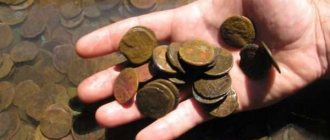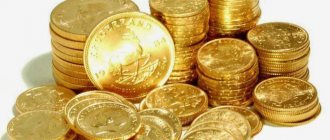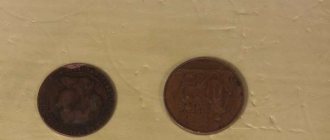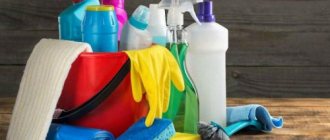Collecting ancient and rare coins is one of the popular hobbies of our time. Wanting to put exhibits in order, many people think about cleaning coins by electrolysis, since this method, despite its relative simplicity, is quite effective. Let's get acquainted with the nuances of this process and safety precautions.
Brief description of the method
The electrolysis method of cleaning products made of copper, nickel, bronze and other metals has found wide application among treasure hunters and collectors. With some experience and proper application, it allows you to achieve good results.
The complex physical and chemical process can be briefly described as follows:
- the electrodes are placed in a special solution;
- current is passed through them;
- due to electrical influence, certain substances are released at the electrodes;
- an electric field is created.
The method can be used even by those with little knowledge of electricity, but it is important to be careful.
Safety precautions
When working with an electrolysis cleaning device, you should follow simple rules that will make the process completely safe.
- Cleaning should take place in a bright room, with the window open.
- Closed clothing with long sleeves and rubber gloves will help protect your body.
- You can’t just plug the device into the network and leave; the process needs to be controlled.
- You should carefully select a power supply. Thus, the recommended operating voltage should not exceed 12 V. Otherwise, there is a high risk of electrocution.
Important!
It must be remembered that the work is carried out with current, so it is important to control each stage.
What is needed for electrolysis?
Cleaning by electrolysis will require minor economic costs. The duration of the procedure is from 10 to 40 minutes, but sometimes cleaning can last for an hour. You should not leave money unattended, soak it in a solution or clean it by electrolysis throughout the day.
For the procedure you will need:
- Two alligator clips or applicator clips, you can purchase them at a hardware store.
- Deep dishes made of glass or plastic; if you don’t have one, a regular glass will do.
- Adapter with power from 6 to 18 amperes.
- Distilled or purified water from a bottle.
- Baking soda or salt.
- Concentrated lemon juice.
- Stainless steel spoon.
Carrying out such a procedure requires the availability of protective equipment. You will need:
- Latex gloves.
- Safety glasses or mask.
The electrolysis process is usually accompanied by the release of gas, so the procedure should be carried out in a well-ventilated area.
If salt was added to the solution to clean money, then during electrolysis the salt ions break down into sodium and chlorine. Chlorine is released in the form of gas. Since contact with this substance is dangerous to human life and health, it is recommended to carry out the procedure with a mask or use soda instead of salt.
When cleaning banknotes, be careful; the adapter may become hot during the cleaning process. If it gets very hot, then you should not leave it without attention - there is a high risk of fire.
Particular attention should be paid to the solution. You need to add 2 tablespoons of soda or salt to the water. Cleaning coins by electrolysis can be done by adding lemon juice to the solution, 20–30 grams is enough. Lemon juice will increase the effectiveness of the procedure and help remove dirt from the metal surface.
Advantages and disadvantages of the method
Among the advantages of electrolysis cleaning of coins are the following.
- High speed (the procedure itself in rare cases will last more than 60 minutes, while soaking coins in olive oil can last more than 30 days).
- Ease of execution: all the work can be done in a regular kitchen.
- If the method is used correctly, the coin will not lose its quality and value for collectors.
- Electrolysis allows you to completely clean the product from oxides and patina.
We recommend: How to clean wooden floors without spending a lot of time on it?
However, it is important to remember some of the disadvantages of the method.
- To fully control the process, you must have some experience or precise knowledge.
- There is a risk of making a mistake and damaging the product.
Despite these disadvantages, the technique is popular.
Peculiarities
Cleaning copper coins by electrolysis has a number of nuances that you should know about before starting the procedure:
- lemon juice will enhance the effectiveness of the procedure, but the acid can harm the metal;
- adding soda to water will also make cleaning more productive, but salt is more effective;
- the release of gas and the appearance of bubbles indicates that the cleaning process has begun;
- If the water does not bubble too actively, then the reason lies in the power of the adapter.
The work of a restorer is difficult to compare with cleaning by electrolysis, but if there are no other options, then you can use a similar procedure.
Coins that are valuable should not be cleaned this way. Before carrying out the procedure, you still need to practice on cheaper coins.
In general, the method is not bad and quite effective, but it is not recommended to risk a valuable piece of the collection. You can try cleaning the metal with a brush or simply washing the coin in warm water with soap.
Metals oxidize for several reasons and sometimes you should leave a coin in its current state if there is a risk that cleaning will do more harm than good to the item. The collector is able to clean the coin himself after purchasing it.
Source
Required Components
Let's look at what you need to prepare to use the electrolysis method to clean coins.
- Power unit. You can use any unit from household appliances, the operating voltage of which is 6-12 V. Options from mobile phones, old set-top boxes, and cameras are suitable.
Advice
If there is a need for electrolysis cleaning of a large number of products, you can purchase a universal power supply.
- Iron spoon or bolt. After electrolysis, such a product cannot be reused, so you should choose one that you don’t mind.
- Paper clip.
- Clothespins or special tucks.
- Plastic or glass glass with warm water.
- Salt or soda. For ½ liter you will need 3 tsp.
Advice
You should not use a very deep container - it is enough for the water to completely cover the coin.
The first stage is preparing the device
The initial step that precedes the cleaning of copper and bronze coins by electrolysis is the assembly of a special device. Let's look at this process step by step.
- Preparing the wire from the power supply. The plug is cut off from it.
- The wire is divided into two parts, each of which must be exposed by about 5-7 cm.
- The next step is to identify the cathode and anode, this can be done simply with a glass of water and salt.
- Pour hot or warm water into a plastic glass. This will speed up the electrolysis process.
- Add salt (or soda) and stir thoroughly, since salt water conducts current better.
- Connect the power supply to the electrical network.
- Dip both wires into the liquid and observe the reaction. The one next to which the water begins to bubble slightly (a kind of hissing occurs) is positively charged. The second one is, accordingly, negative.
Having remembered which wire has a positive charge and which has a negative charge, the power supply from the network must be turned off.
We recommend: What are the benefits of vodka in everyday life? Cleans, removes odors and more
How is the procedure done?
Step-by-step cleaning description:
- first, disconnect the stamp from the adapter and expose the wires;
- then install clamps to each wire;
- prepare a solution for the procedure;
- find out which terminal the negative charge goes to and which the positive charge goes to.
A wire with a positive charge should go to the spoon, and a wire with a negative charge should go to the coin. If you can’t figure out the wires yourself and you don’t have a tester at hand, you need to place a spoon and a coin in the water so that they don’t touch each other. If a wire carrying negative current is connected to a spoon, it will begin to bubble; if this wire is connected to a coin, it will begin to bubble.
Electrolysis cleaning steps
The minus is not capable of harming the metal of the coin, but it is still worth carefully monitoring its condition. Periodically remove the product from the solution and check the degree of cleaning.
Observing the process, you can see how dirt peels off the surface of the metal and moves away. Cleaning coins involves changing the color of the solution. During the procedure, it is able to change color, darken and turn black. This happens not only because the dirt moves away from the metal, but also because the clamps in the solution oxidize.
After the procedure, it would be useful to polish the money - they must be rinsed under a stream of water, and the surface cleaned with a toothbrush. The surface of the metal is then polished using a piece of suede. If there is no suede, then wool without lint and pellets will do.
During the cleaning process, you may notice how the surface of the coin becomes covered with black flakes. You can easily get rid of them by brushing: for this you need to periodically check the degree of contamination of the product, removing it from the solution every 15 minutes.
Don't go overboard as cleaning with electrolysis can cost you money. Minor damage may form on the metal surface and the patina will disappear.
If the dirt stuck to the coin cannot be cleaned, then you should not experiment and repeat the procedure using electrolysis; it is better to give the coin to a restorer for cleaning.
Preparing for cleaning
So, the device for electrolysis at home is ready. Now you need to prepare the coin and begin the process. How it's done?
There are two cleaning methods.
- During the first, aggressive one, the coin is attached to the “plus”. In this case, the cleaning process will go faster.
- In the second case – to the “minus”. The process is easier to control, but it will take longer.
Having chosen a method (for beginners it is best to start with the second and first clean the product, which is not of particular value), you need to attach the coin and the iron product to the wires.
First, a paper clip is attached to the selected wire; it will securely hold the coin. An iron object is attached to the other.
Advice
To clean rare and valuable copper coins, it is best to choose a more gentle method by connecting the product to the minus.
Drying coins
It is imperative to dry cleaned coins. If this is not done, they will oxidize and their appearance will deteriorate. You can do this this way: after washing, place the coins on a paper towel folded several times and blot. You can wipe the products with a cloth, but it is very important that it does not leave marks. Cotton fabric is best. They also use a drying cabinet, but it is very important to remember that the temperature should be low, no more than 100 degrees.
Cleaned coins look unnatural because they have no patina. Over time, it appears, although it may lie unevenly. There is a way to avoid this: after cleaning, the coin can be aged.
To do this, you need a substance used in photo laboratories - hyposulfite. The coin is dipped in a 10% solution for 10–15 minutes, after which it is taken out and wiped dry. A nickel-copper coin can be opened with varnish for safety. Another option is to lubricate the coin with alcohol and petroleum jelly, which will also protect it from further exposure.











